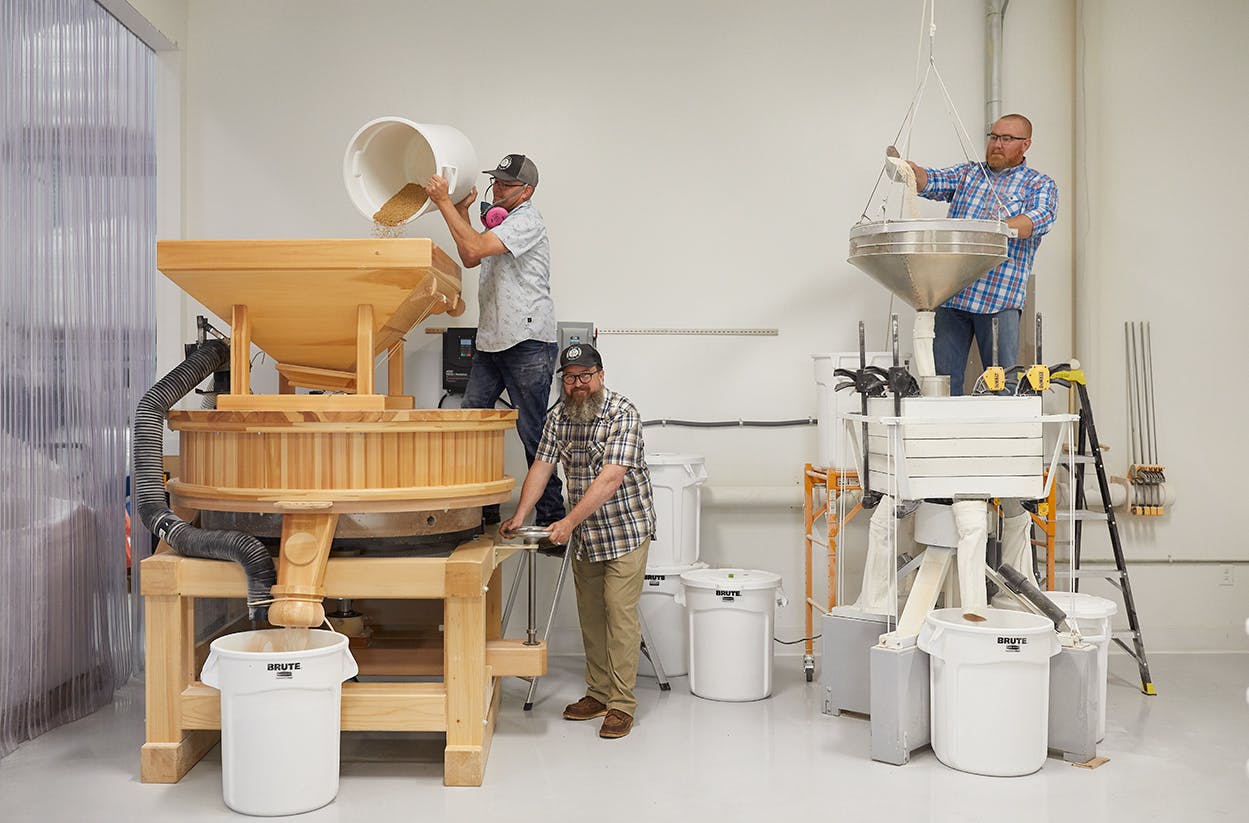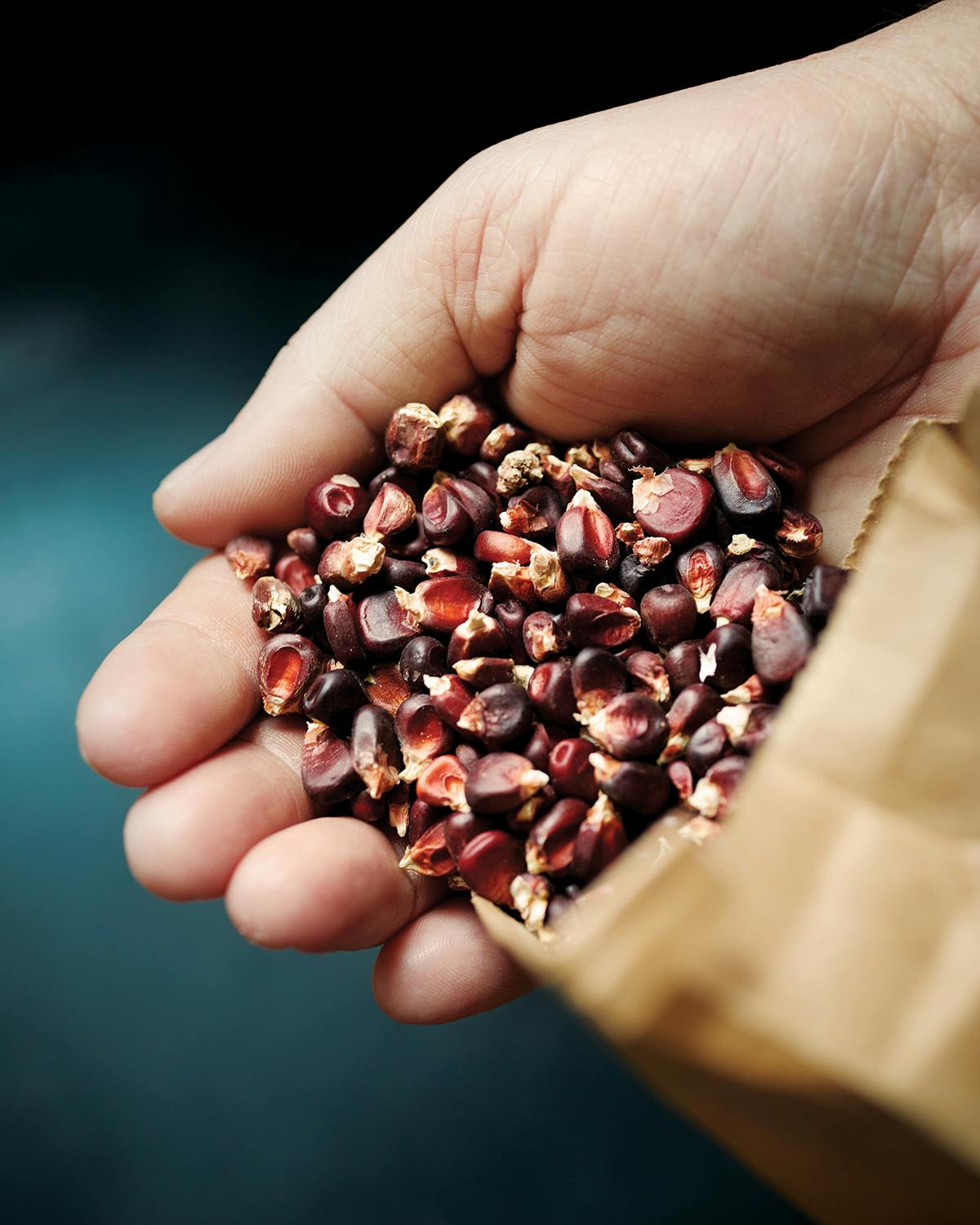The smell of fresh stone-ground whole-grain flour is unmistakable. Like bread but raw. It’s a scent that carries the promise of pizza, pasta, cakes, dumplings, tortillas. It’s immediately recognizable, despite the fact that you’ve likely never smelled it before, unless you’ve visited a place like Barton Springs Mill.
The Hill Country’s first new mill in more than a century, Barton Springs opened in 2017 in a five-thousand-square-foot building on Frog Pond Lane, in Dripping Springs. The warehouse sits in a small industrial park with identical buildings, but only one contains hulking machines that include a 1930s Clipper seed cleaner, an imported Austrian Osttiroler mill bearing two 1,500-pound millstones, and a hammer mill that breaks down grains for brewing and distilling. Surrounding the equipment are dozens of one-ton vacuum-sealed bags full of heirloom grains as well as chest freezers packed with seeds to grow long-forgotten varieties of corn and wheat. There’s a makeshift area for baking classes, and a tiny retail space offers brown paper sacks of whole grains for sale. In the middle of it all, sporting a big, bushy beard and brown Carhartt overalls like an organic farming Santa Claus, is owner and miller James Brown.
“Miller” is an inadequate description of Brown’s role. After retiring from a three-decade career in church music, including fifteen years at Austin’s First Presbyterian, he’s now orchestrating a statewide renaissance of artisanal and ancient grains. Although Brown focused most of his professional life on music, he is no stranger to the food world; he has a culinary degree, has worked in restaurants, and is a passionate baker. “I got into this because I wanted a better loaf of bread—it’s just a stupid extreme to go to,” he says, laughing. “I inadvertently became an activist for the farmer.”

To make better bread you need better flour. And to make better flour you need better grains. Brown started Barton Springs Mill because he couldn’t find high-quality flour for his baking needs, and after asking local chefs and bakers, he found he wasn’t alone—and that grains were at the heart of the problem. Grain requires hefty infrastructure to get from farm to oven, including facilities for small-scale cleaning, hulling, and stone-milling. Such operations were once commonplace, but as industrial farming proliferated in the twentieth century, they largely disappeared. Without mills to process their crops, small Texas farmers had little incentive to grow grain.
Brown had a hunch that if he created such a mill, more farmers, responding to the demand for locally sourced food, would rotate grain in with their cash crops. And that gamble seems to have paid off: in two short years, Barton Springs’ business has exploded. Among the sixty or so Texas restaurants using its products are Austin’s Emmer & Rye, Dallas’s Petra and the Beast, San Antonio’s Cured, Houston’s Nancy’s Hustle, and Marfa’s Cochineal. Bakeries and distilleries are also important customers.
Brown “is the real deal,” says Meaders Ozarow, the founder of Empire Baking Company, a wholesale bakery that has become a Dallas institution since it opened more than 25 years ago. Ozarow had spent years looking for the right supplier of locally grown grain flour that could handle Empire’s volume. The bakery now produces a Barton Springs Mill sourdough-type loaf, and Ozarow hopes to add more varieties. Drawing a comparison to the early days of the farm-to-table movement, when chefs and customers started demanding higher-quality strawberries and salad greens, she says, “We have a phrase at the bakery: ‘We’ve seen this movie before. We know how it ends.’ James Brown? People with that kind of intelligence and that kind of business sense? They work out.”
Brown now serves as matchmaker, distributor, retailer, analyst, and advocate for Texas’s grain community. Those tasks require someone with a knack for communicating with very different types of people—from high-end chefs to High Plains farmers—and Brown is equally at ease with all of them. He persuades Texas farmers from Tokio (near West) to Lamesa to grow his seeds; he hunts down rare corn varietals to produce limited-run bourbons; he drives to Dallas and Houston and Marfa to make sure bakers have access to his product.

Minibar Springs eternal
Not just a swimming hole, Austin’s Barton Springs once turned the massive millstones of the area’s last flour mill, destroyed by a fire in 1886. Barton Springs Mill is named in its honor.
But the mill’s success is about more than one man’s talent for salesmanship. The company is part of a national trend in reviving local grains, which make for healthier and more flavorful products. In 2009 farmers’ markets in New York City began requiring bakers to use at least 15 percent local grains in their baked goods. On the other side of the country, the California Grain Campaign has set a goal of getting farmers’ market bakers to use 20 percent local grains by 2020.
Abby Love, a former pastry chef at hyperlocal Austin restaurant Dai Due who teaches baking classes at Barton Springs, compares the difference between freshly milled whole-grain flour and the stuff you find in the supermarket baking aisle to “a freshly clipped piece of heirloom broccoli versus Green Giant.” She also notes that different types of wheat have different purposes, which is why Barton Springs offers a wide variety of flours. “It’s like apples,” she says. “There’s Red Delicious; there’s Granny Smith. Some are good for eating, some are good for applesauce, some are good for pies. It’s no different with wheat.” (Find Love’s recipe for summer fruit scones, using Barton Springs Mill flour, here.)
The process starts with seeds: Barton Springs Mill stocks its own, searching for heritage varieties that were commonly grown in Texas over a century ago. It then finds farmers who are willing to grow the seeds, which it gives to them as a loan. Richardson Farms, in Rockdale, grows corn in collaboration with Brown. Owner Jim Richardson says the partnership has been instrumental in transforming his business. “It’s allowed me to sell to these high-end restaurants that demand extremely good quality,” he says. “If I didn’t have James in the middle helping me, I couldn’t have the markets that I have.”
The mill is also benefiting from the growing number of Texas distilleries. Barton Springs’ biggest distilling partner is Daniel Barnes, the founder and head distiller of neighboring Treaty Oak Distilling. He, like Ozarow in Dallas, had been looking for a local grain provider for quite a while before he met Brown. He now uses Barton Springs Mill grains for bourbon and rye and is working on a series of whiskeys made from the mill’s heirloom corns, including Bloody Butcher Red and Oaxacan Green.

The distillery itself sits outside Dripping Springs on a beautiful, live oak-studded, 28-acre property, two and a half acres of which will soon house the new Barton Springs Mill headquarters; the current facility is full to bursting. At 17,500 square feet, the new building will be three-and-a-half times its current size. It will include storage for four hundred tons of grain; malting facilities; a hulling machine that’s being purchased with a grant from the Austin Food and Wine Alliance; and a dedicated classroom for baking classes and demonstrations.
The new setup will allow Barton Springs to vastly expand its offerings. Currently, the mill sources einkorn, emmer, and spelt from out of state because their hulls have to be removed before milling. The new hulling machine will make it more practical to grow those ancient grains in Texas. Brown is also leasing 2,500 square feet of the building to Love, who will operate a bakery, pizzeria, and retail space called L’Oven. Brown plans to live on-site, above the mill, with his wife.
“We’ll see what happens with the market in the next couple years,” he says, “if this is a fad or if it continues.” Far from wanting to monopolize the market, he thinks Texas is big enough for another mill, another grain hub. “There’s room,” he says, “for another one of me.”
This article originally appeared in the August 2019 issue of Texas Monthly with the headline “The Grain Changer.” Subscribe today.
- More About:
- Dripping Springs








